A classic with a twist, fill up on this amazing Korean rice bowl! This easy chicken bibimbap is topped with marinated chicken mince, spinach, bean shoots, bibimbap sauce and the iconic sunny side-up egg.
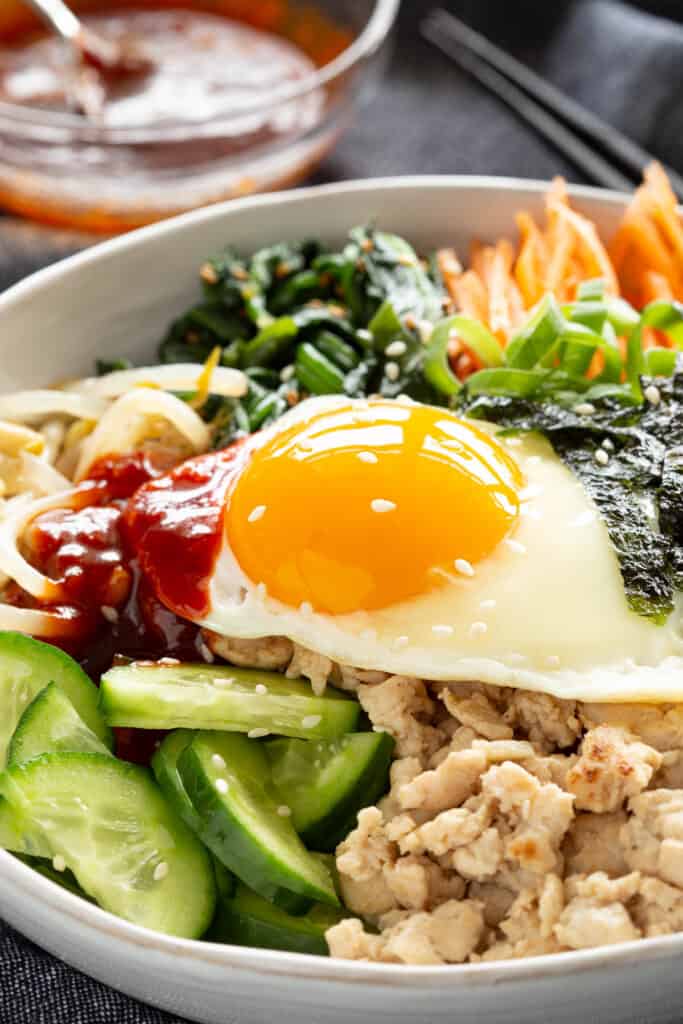
In This Post You’ll Learn
Why We Love This
If you love rice bowls, you’ll love this fun and colourful chicken bibimbap recipe. Drizzled with a spicy bibimbap sauce, it has the perfect balance of sweet and savoury flavour.
It’s so quick and easy to make with minced chicken, cooked rice, and your choice of fresh veggies or traditional banchan (Korean side dishes).
Bibimbap is endlessly adaptable (perfect for fussy eaters) and a great way to save time and use up leftovers from your fridge!
Related: Beef Bulgogi / Chicken Bulgogi / Kimchi Fried Rice
Top 5 Korean Banchan To Serve with Bibimbap
Banchan are simple side dishes, often served alongside a main dish in Korea.
Here’s our top 5 banchan to serve up alongside your Korean rice bowls:
Pickled Daikon – Danmuji
Pickled Garlic – Maneul Jangajji
Braised Potatoes – Gamja Jorim
Pickled Onion – Yangpa Jangajji
Bean Sprout Soup – Kong Namul Guk
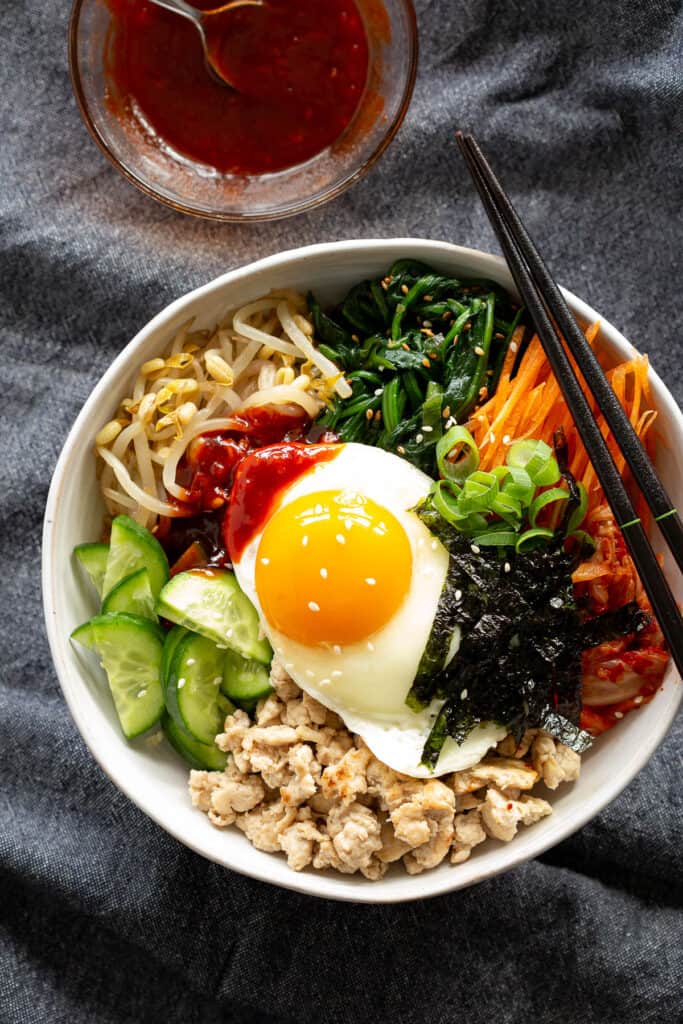
What is Bibimbap?
Bibimbap (비빔밥 / sometimes romanised as bi bim bap or bi bim bop) means mixed (bibim) rice (bap) in Korean.
This traditional Korean mixed rice bowl is topped with meat and a colourful range of banchan (side dishes) consisting of lightly seasoned, blanched or sauteed vegetables.
While there are standard toppings for bibimbap, there are no hard and fast rules. Instead, this dish is all about customising – so feel free to save time and use up leftovers!
Traditional bibimbap rice bowls are often made with raw beef and raw egg, however today we’re sharing our favourite variation of bibimbap. Our recipe features chicken mince instead of beef, flavoured with typical Korean seasonings, and slathered in our spicy homemade bibimbap sauce.
What You’ll Need
For the chicken:
- Chicken Mince – Aka ground chicken. You can use beef, pork or turkey mince, or sub with crumbled tofu if you prefer.
- Seasonings – You’ll need soy sauce, sugar, Chinese cooking wine (sub with Japanese cooking sake), garlic, sesame oil and pepper.
For each bibimbap bowl:
- Korean Seasoned Bean Sprouts (Sukju-Namul) – Blanched bean sprouts seasoned with soy sauce, sesame oil and garlic. Sub with plain blanched bean sprouts.
- Korean Seasoned Spinach (Sigeumchi-Namul) – Blanched spinach seasoned with soy sauce, sesame oil, sugar, garlic and toasted sesame seeds. Sub with blanched spinach or just use fresh, chopped spinach. Sub with plain blanched spinach or thawed frozen spinach.
- Kimchi – Use your favourite style of store bought kimchi or try making your own homemade kimchi!
- Other Veggies – Thinly sliced cucumber and julienne / grated carrot. You can also use pickled cucumber or pickled carrots and daikon.
- Sliced Seaweed Sheets – Use Korean style roasted seaweed sheets (gim-gui / 김구이) cut into thin strips. Their saltiness is amazing with homemade bibimbap! Sub with Japanese style nori sheets for sushi if you have them on hand.
- Bibimbap Sauce – Store bought or make your own quick and easy bibimbap sauce.
- Egg – Sunny side-up with runny yolk, otherwise cook to your liking.
- Cooked Rice – Traditionally this dish is served with short grain rice. Sushi rice or jasmine rice both work well. Sub with brown rice or even freekeh for a healthy option.
More bibimbap ingredient ideas:
Add your favourite veggies, pickles and more, such as lettuce, capsicum, purple cabbage, quail eggs, shiitake mushrooms, daikon pickles (danmuji), cucumber pickles (oi muchim) or seasoned soybean sprouts (kong-namul). Or top with teriyaki tofu or spicy braised tofu.
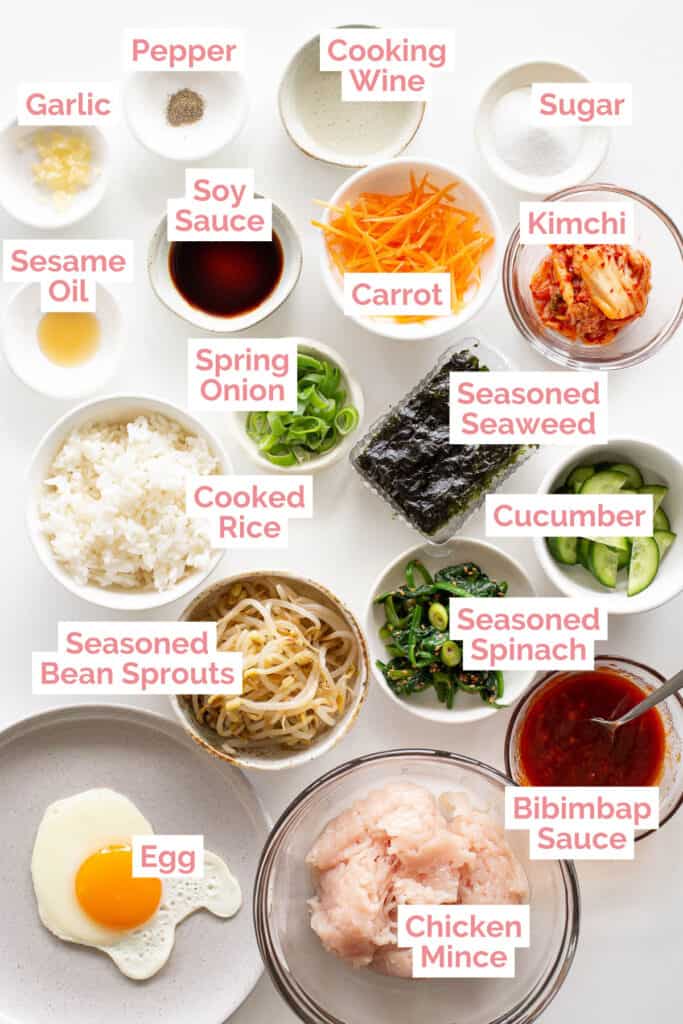
How to Make Bibimbap with Chicken!
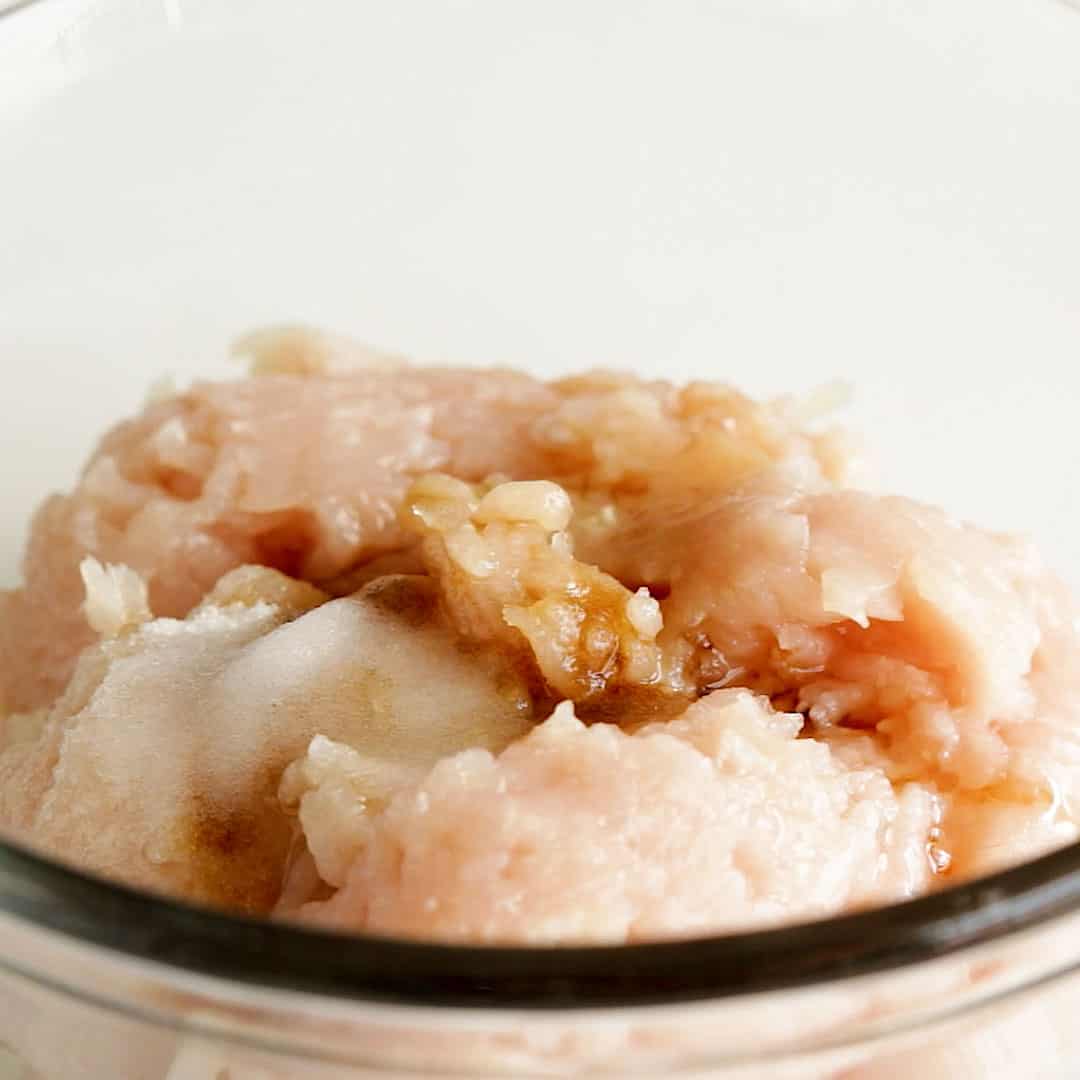
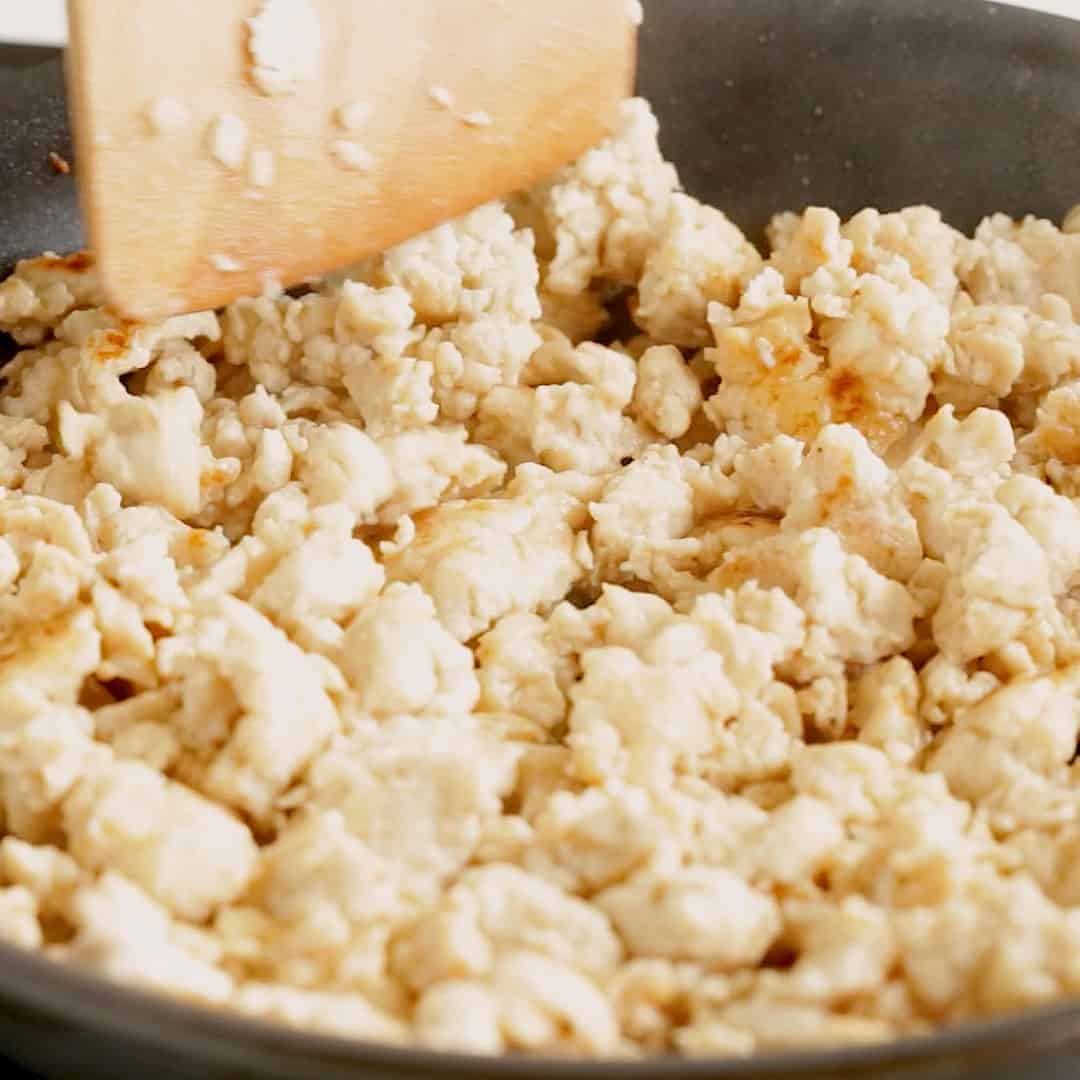
First, gather your ingredients: See recipe card below for measurements.
- Place chicken in a mixing bowl and add the soy sauce, sugar, Chinese cooking wine, garlic, sesame oil and pepper. Mix well.
- Heat the vegetable oil in a medium frying pan and add the seasoned chicken. Stir fry for around 3-5 mins until browned and cooked through.

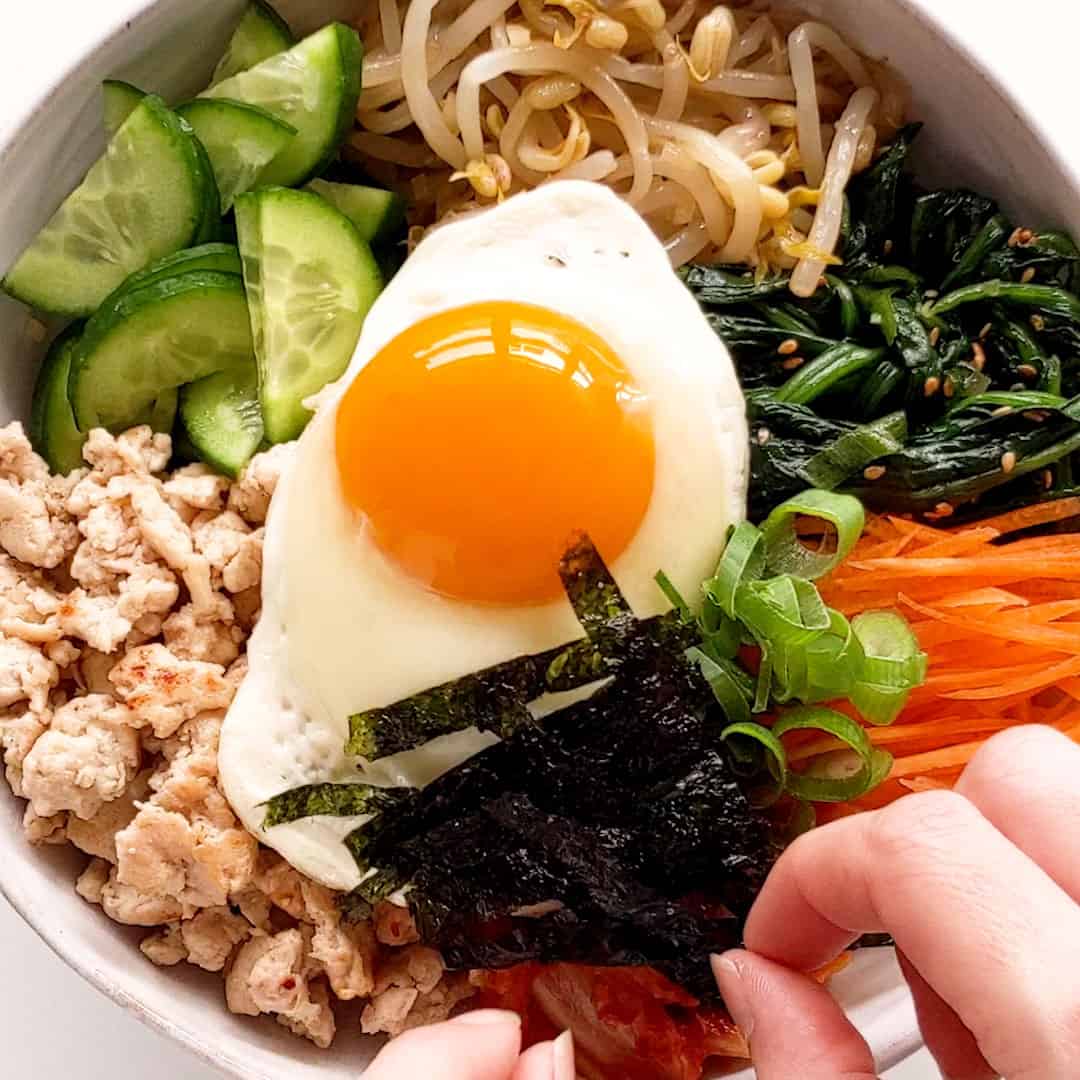
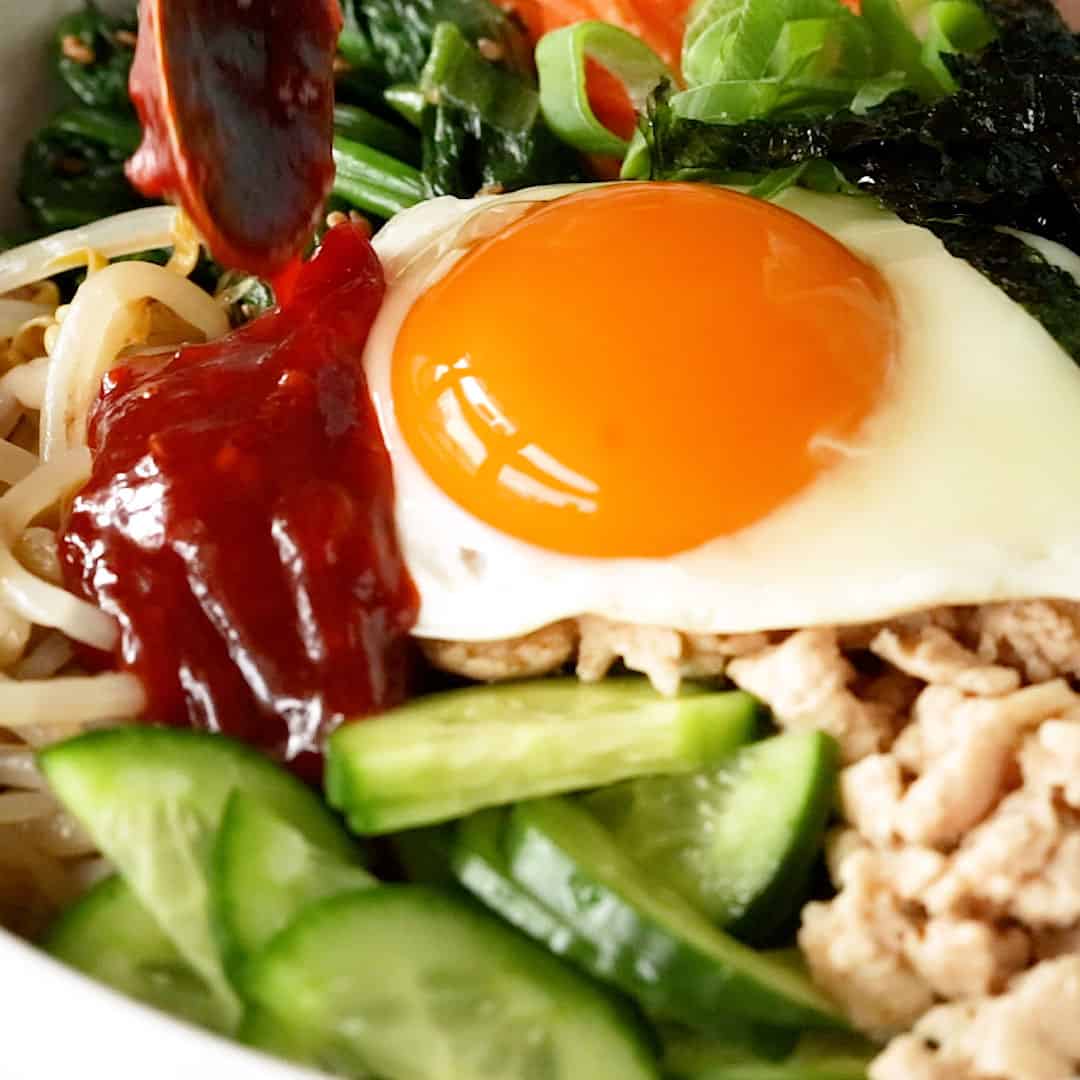
- Note: For this step, make sure the pan is non-stick, as adding butter or oil won’t give you that nice clean sunny side-up finish. Wipe out the pan, and allow to reheat over medium heat for 30 seconds. Now add one egg per person and fry it sunny side up (or according to preference) for a few minutes, or until the white has cooked through and is no longer translucent.
- Place cooked rice into a wide serving bowl. Top with cooked chicken and your choice of seasoned bean sprouts, seasoned spinach, kimchi, cucumber and carrot. Lastly, top with fried egg and seasoned seaweed strips.
- Drizzle with bibimbap sauce and add any other chosen garnishes and serve.
Wandercook’s Tips
- Presentation – Get fancy with perfect presentation OR throw everything in together and mix it all up. It’s entirely up to you and totally delicious either way!
- Batch Cook – Why not double the ingredients to have plenty for leftovers the next day.
- Storage – All bibimbap ingredients store well for 2-3 days in the fridge in airtight containers.
FAQs
Both, depending on the season. Serve cold in summer for a refreshing meal, or hot in winter to warm you up.
Yes, you can freeze most of the bibimbap ingredients except the cucumber and fried egg
Variations
- Other Proteins – This dish is amazing with flank steak or boneless chicken breast (diced or sliced). Try it with chicken karaage (crispy panko fried chicken)!
- Other Spicy Sauces – Try it with all purpose gochujang sauce, gochujang mayo, or sriracha mayo.
- Non Spicy Bibimbap – Season the chicken with non spicy bulgogi sauce and skip the bibimbap sauce when serving, or serve with kewpie mayo instead.
- Optional Garnishes – Toasted sesame seeds, gochugaru chilli flakes, gomashio sesame salt, shichimi togarashi, aonori, fried garlic or fried shallots.
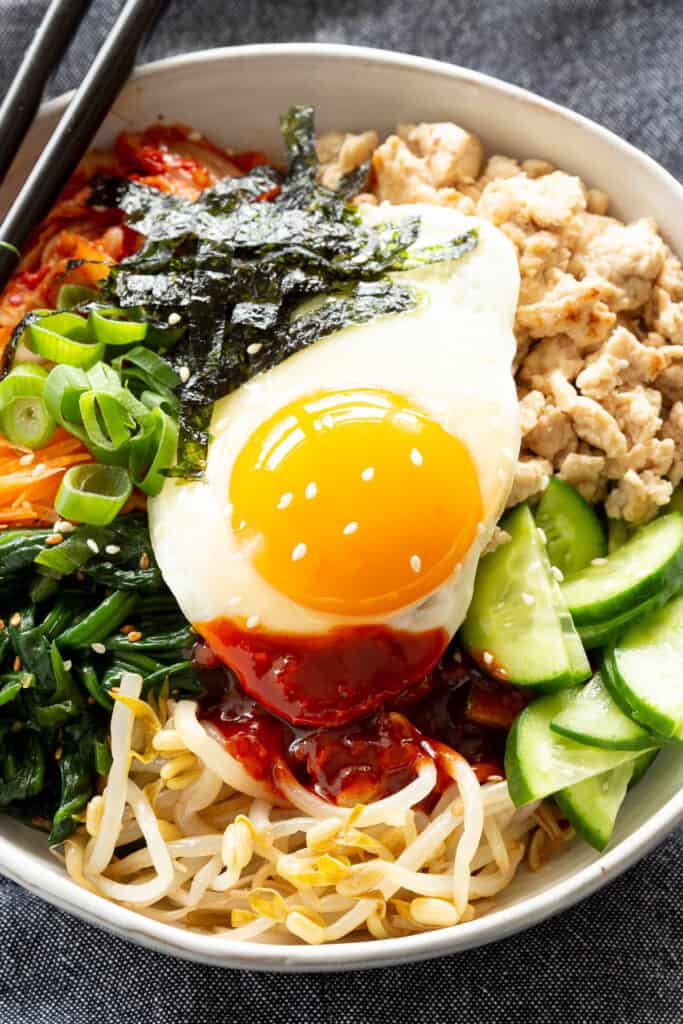
Try these amazing recipes next:
★ Did you make this recipe? Please leave a comment and a star rating below!
Ingredients
For the chicken (two serves)
- 300 g chicken mince sub beef, pork or tofu
- 4 tsp soy sauce
- 2 tsp sugar
- 2 tsp cooking rice wine / cooking sake
- 1 garlic chopped
- 1 tsp sesame oil
- 1 pinch pepper
- 1 tbsp vegetable oil
For each bibimbap bowl
- ¼ cup Korean seasoned bean sprouts aka sukju namul, sub with plain blanched bean sprouts
- ¼ cup Korean seasoned spinach aka sigeumchi namul, sub with plain blanched spinach
- ¼ cup kimchi
- ¼ cup cucumber sliced thinly
- ¼ cup carrot sliced julienne or grated lengthways
- 2 sheets seasoned seaweed cut into thin strips
- 2 tbsp bibimbap sauce
- 1 egg fried sunny side up
- ¾ cup cooked short grain rice sushi rice works well
More optional bowl ingredients:
- lettuce chopped
- capsicum / bell pepper sliced thinly
- purple cabbage sliced thinly
- quail eggs
- shiitake mushrooms
- takuan / daikon pickles danmuji
- Korean cucumber pickles oi muchim
- Korean seasoned soybean sprouts kongnamul
Instructions
- Place chicken in a mixing bowl and add the soy sauce, sugar, Chinese cooking wine, garlic, sesame oil and pepper. Mix well.300 g chicken mince, 4 tsp soy sauce, 2 tsp sugar, 2 tsp cooking rice wine / cooking sake, 1 garlic, 1 tsp sesame oil, 1 pinch pepper
- Heat the vegetable oil in a medium frying pan and add the seasoned chicken. Stir fry for around 3-5 mins until browned and cooked through.1 tbsp vegetable oil
- Note: For this step, make sure the pan is non-stick, as adding butter or oil won’t give you that nice clean sunny side-up finish. Wipe out the pan, and allow to reheat over medium heat for 30 seconds. Now add one egg per person and fry it sunny side up (or according to preference) for a few minutes, or until the white has cooked through and is no longer translucent.1 egg
To assemble:
- Place cooked rice into a wide serving bowl. Top with cooked chicken and your choice of seasoned bean sprouts, seasoned spinach, kimchi, cucumber and carrot. Lastly, top with fried egg and seasoned seaweed strips. Drizzle with bibimbap sauce and add any other chosen garnishes and serve.¼ cup Korean seasoned bean sprouts, ¼ cup Korean seasoned spinach, ¼ cup kimchi, ¼ cup cucumber, ¼ cup carrot, 2 sheets seasoned seaweed, 2 tbsp bibimbap sauce, ¾ cup cooked short grain rice
Video
Nutrition
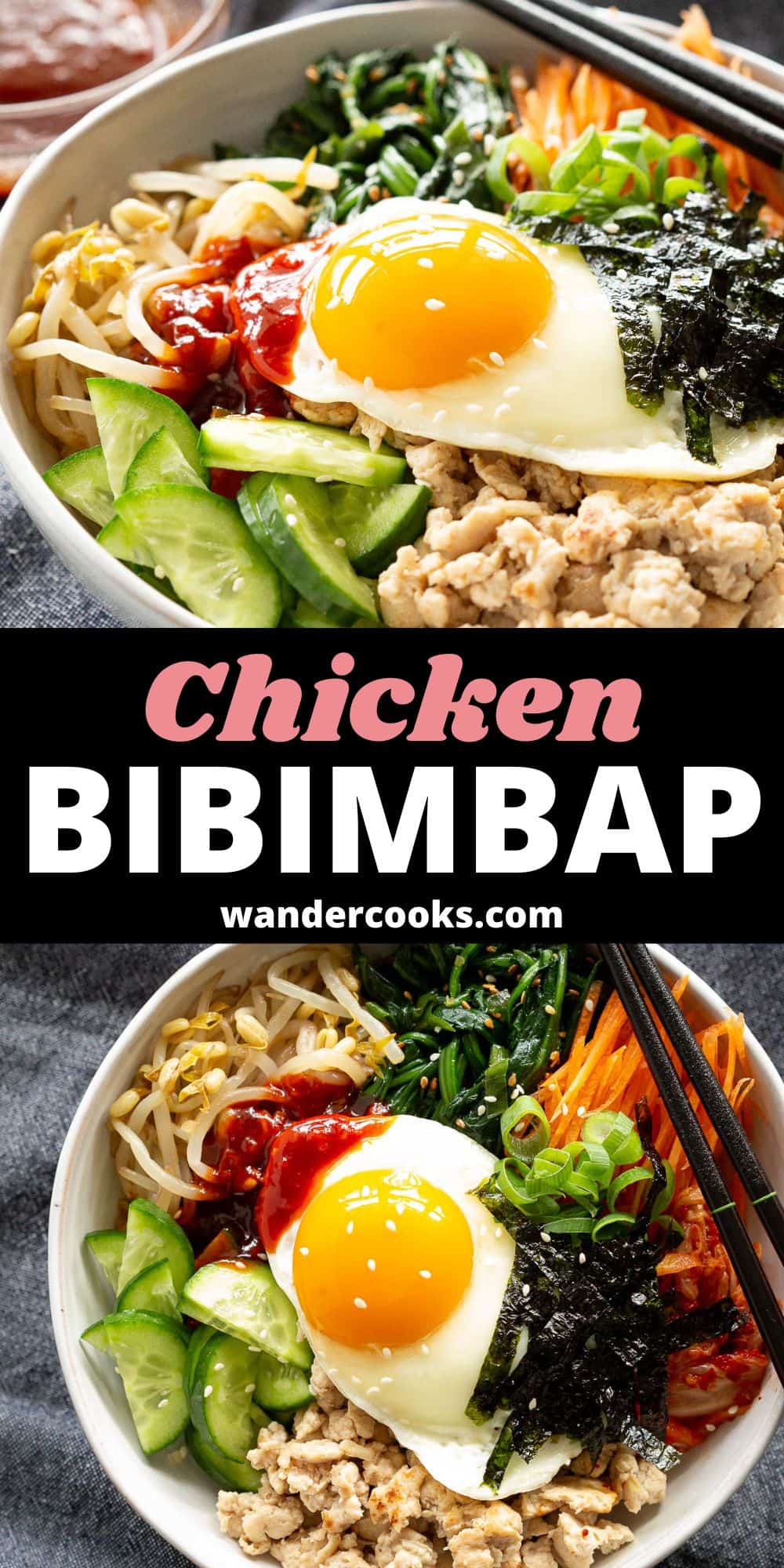

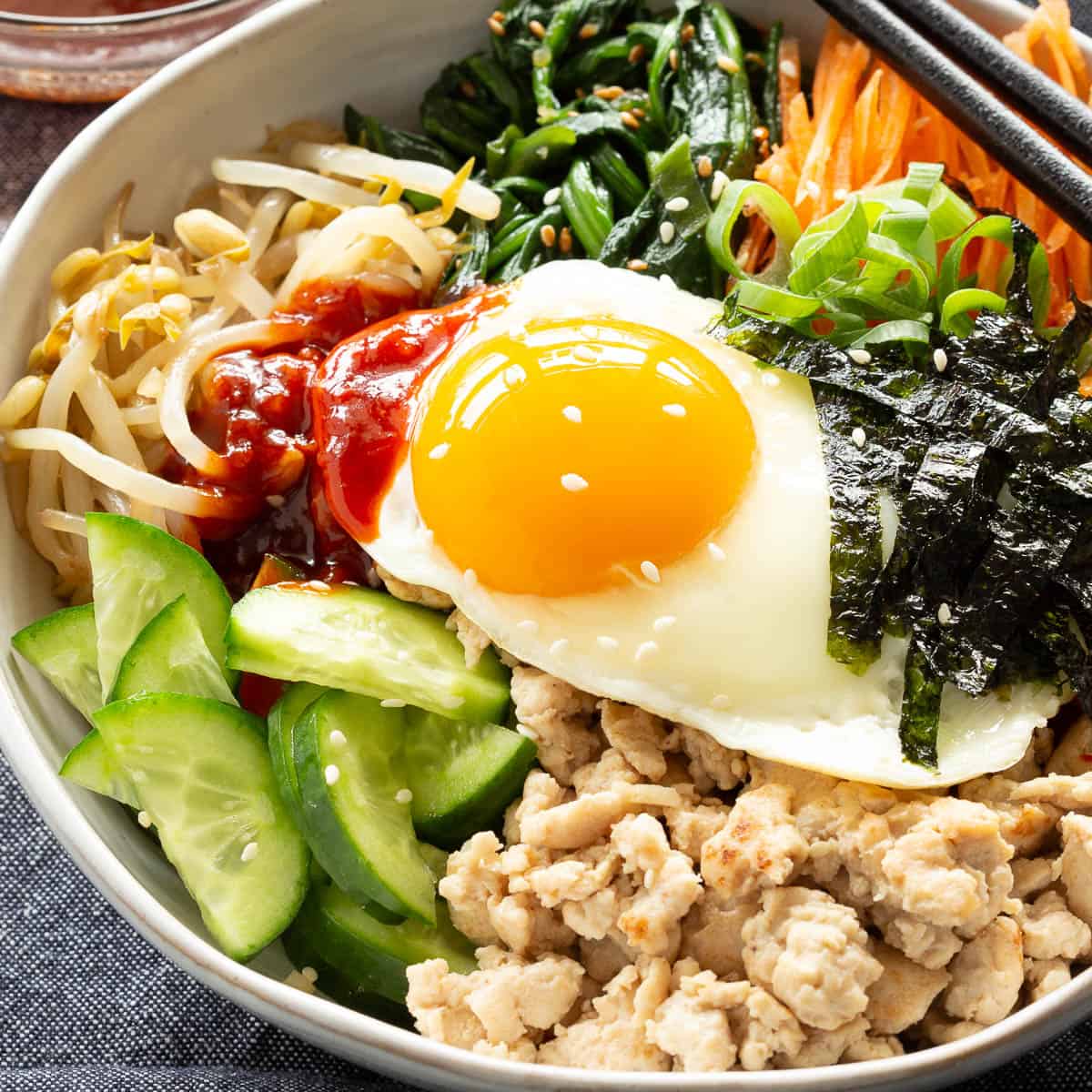



No Comments